Operation Plunder was the British and Canadian operation to cross the Rhine river on 23 March 1945, launched by the 21st Army Group under Field Marshal Bernard Law Montgomery. The crossing was made between Rees and Wesel by the British 2nd Army under General Sir Miles Christopher Dempsey, and south of Wesel between Wallach and Rhienburg by the elements of US 9th Army under Lieutenant General William Hood Simpson. Operation Varsity, the airborne element of Plunder was the last major Allied airborne operation of WWII.
Elements of the British 51st Highland Division crossing a bridge at Rees, Germany.

The Rhine is one of the major rivers in Europe. The river begins in the Swiss canton of Graubünden in the southeastern Swiss Alps. It forms part of the Swiss-Liechtenstein, Swiss-Austrian, and Swiss-German borders. After that the Rhine defines much of the Franco-German border, after which it flows in a mostly northerly direction through the German Rhineland and ends east of Nijmegen at Pannerdense Kop in the Netherlands. It is considered the traditional border of Germany which in 1945 no foreign army had crossed it in 140 years (since Napoleon’s army in 1805). The Rhine was more of a symbolic barrier than a physical defense line. In March 1945, seven Allied armies, (from south to north) the French 1st, US 7th, US 3rd, US 1st, US 9th, British 2nd and the Canadian 1st Armies were posed along the west bank of the Rhine.
The US 1st Army (commanded by General Courtney Hicks Hodges) had the honor of being the first Allied army to cross the Rhine. On 7 March 1945, elements of the US 9th Armored Division captured the still intact Ludendorff Bridge at Remagen. On March 10th, the first Allied bridgehead across the Rhine was established. At 0510 hours on Saturday, March 11th, the first Allied steel tread way bridge across the Rhine was completed.
Landing Vehicle Tracked (LVT)
LVTs or Amtracks were built by the Food Machinery Corporation (FMC) at their Lakeland Plant in Florida, USA. They saw far less use in Europe than in the Pacific. They were not employed in Italy or France simply because the Pacific Theater had priority. LVT deliveries to the ETO had not started until late summer 1944 with most of them going to the British Army. In British service, all LVTs were named “Buffalo”. A large number of LVT-2s and LVT-4s were assigned to the British 79th Armoured Division which employed a wide selection of specialized vehicles. They were first used to help secure the sea approaches to Antwerp in the late fall of 1944 against the German held islands in the Scheldt Estwary.
The LVT-2 Buffalo or LVT II in British service had the same Continental radial 7-cylinder engine used in the US M3A1 Stuart light tank in the rear of the hull with the prop shaft running along the center line to the transmission at the front. It could carry a normal payload of 6500 lbs (2900 kg) or 16 fully equipped troops. The troops or cargo had to be loaded/unloaded over the sides.
The LVT-4 Buffalo (LVT IV) had the engine and transmission moved to the front. The hull length was increased and at the rear was a large ramp door which allowed loading/unloading of the vehicle.
The LVT-4 could carry:
- 30 fully equipped troops
- a Jeep
- a Universal Carrier
- an airborne bulldozer
- a 6 pounder anti-tank gun
- a 25 pounder field gun
- 4 tons of cargo
Some British LVT IVs had increased firepower and protection which mounted a 20mm Polsten cannon over the front cab and the side mounted machine guns had box shaped gun shields.

These are the census numbers for all the LVTs the British received.
| Census Number Range | Number Built |
|---|---|
| P5360762 to P5360763 | 2 |
| P5585904 to P5585920 | 17 |
| P5809030 to P5809057 | 28 |
| P5822012 to P5822261 | 250 |
| P5877262 to P5877461 | 200 |
| P6110269 to P6110374 | 106 |
| P6165024 to P6165223 | 200 |
| Total | 803 |
Source: Central Ordnance Depot Chilwell.
The prefix “P” stands for Amphibious. There is no information on which ones or how many were LVT IIs or LVT IVs.
Video: Tank Chats #58 Buffalo & Weasel
Amphibious Shermans
DD or duplex drive tanks, nicknamed “Donald Duck tanks” were a type of amphibious swimming tanks which was developed by the British during WWII. It was a conversion which made a standard tank amphibious. A deck was welded around the tank’s hull and permanently attached to it was a collapsible flotation screen made of waterproofed canvas. Inflation of rubber air pillars, powered by two compressed-air bottles erected the screen and it was locked in place by metal struts. Once erected, the screen covered the top half of the tank effectively creating a canvas hull, greatly increasing the vehicle’s freeboard (height of a vessel’s side between the waterline and the deck) which provided buoyancy in the water. The thickness of the flotation screen varied. The bottom layer was 3 canvases thick, the mid layer was 2 canvases, and the top layer was 1 canvas thick. When the screen was collapsed, it did not interfere with the tank’s mobility or its combat effectiveness. The Duplex Drive was a two propeller unit mounted on the rear which was driven by the bevel drive of the tank and it provided a water speed of 4.6 mph (7.4 km/h).
Trails for the prototype of the Duplex Drive Valentine tank began on 21 May 1942 and it was successful, although it did sank when the flotation screen was punctured by machine gun fire. A minor drawback with the Valentine tank was the turret had to be pointing to the rear of the tank in order for the canvas to be erected. By April 1943, the DD conversion was adapted for the US M4 Sherman tank which was more suitable as it could move in the water with its main gun facing forward ready to fire as soon as the screen was collapsed. The Valentine DDs were used mainly for training and the majority of the US, British, and Canadian DD crews did their preliminary training with them. The first combat use of DD tanks was on 6 June 1944, D-Day. They were also deployed in Operation Dragoon, the Allied invasion of southern France on 15 August 1944.
The British DD tanks were based on the lend leased M4A2 (Sherman III) or the M4A4 (Sherman V). The US DD tanks were based on the M4A1 Sherman. Only Shermans with 75mm guns were converted. In the summer of 1945, two prototypes of the M4A3E8 DD Sherman were converted and tested for the invasion of Japan.

Video: Tank Chats #56 Sherman DD
Preparations
Preparations for the Rhine River crossing rivaled that of the Normandy invasion in scale. Massive numbers of tanks, vehicles and materials were transported to assembly areas along the west bank of the Rhine river. The LVT Buffalo had specially designed tracks which propelled it in the water, however its tracks suffered damage when driving on hard surfaces so the all Buffaloes were transported by truck from Holland. The massive Allied build up along the Rhine was very carefully concealed and camouflaged.
Starting on March 10th and continuing throughout the crossings, Allied smoke companies generated a massive smoke screen from west of Cleve up to and over the Rhine river where it joined the US Army smoke screen which covered the US sector to the south. This screen made the headlines in the British Army newspaper “Soldier”, and in English newspapers which generally described it as a man-made 66 mile (106.2 km) long “fog”. To keep the Germans guessing the locations of the crossing points, a plan was devised and instituted a schedule of “smoke” and “no-smoke” days for all areas. It was also hoped that the smoke might draw enemy fire and assist in locating enemy positions on the east bank.
LVT Buffaloes of 4th RTR are being transported forward. M19 Tank Transporters (US 12-ton 6×4 M20 Diamond T Model 980 tractor and 12-wheel M9 trailer) carrying the LVTs are halted near Xanten, Germany, on 21 March 1945.

LVT IV Buffaloes are being unloaded from tank transporters near Xanten. This Buffalo has a 20mm Polsten cannon mounted on top of the front cab.
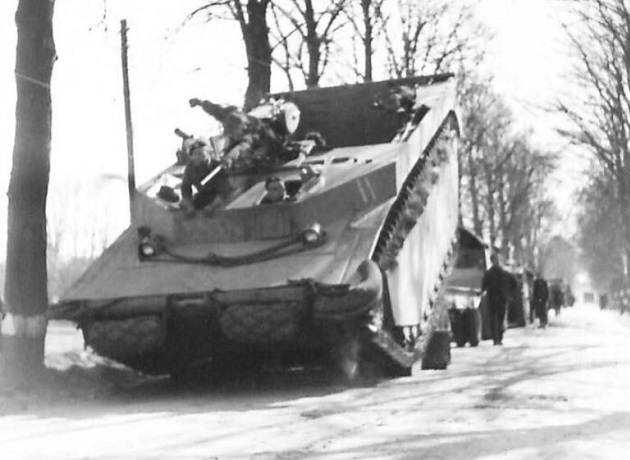
After the Buffaloes were unloaded from the transports, they were driven into a nearby wood and were carefully covered and camouflaged.

DD tanks climbing up the muddy banks on the opposite side of the river was a problem. A number of LVTs were modified with a frame arrangement which laid down a reinforced canvas carpet or a chestnut paling carpet.

A Sherman Armoured Recovery Vehicle I (ARV) and other equipment moving up to the Rhine on March 24th. Driving up beside the Sherman ARV is a Churchill Armoured Vehicle Royal Engineers (AVRE) armed with a 230mm Petard spigot mortar “flying dustbin” which is towing a trailer carrying a pontoon bridge component.

British Crossing points
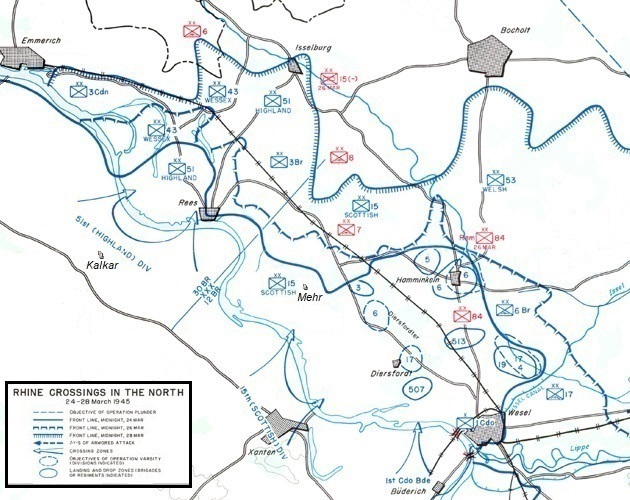
Operation Turnscrew was the British crossing of the Rhine in the area of Rees during the night of March 23-24. At 1800 hours on the 23rd, the crossing began with a barrage of 5500 guns along the 35 km (21.7 miles) front and a RAF bomber raid over Wesel as a deception. At 2100 hours, four assault battalions of the two leading brigades, loaded in LVT Buffaloes, advanced in columns northeast of Kalkar through the flood water on the river’s western bank, moved down into the water at their appointed places, and swam across the river to make landfall on the eastern bank.
British 51st (Highland) Infantry Division
- 152nd, 153rd and 154th Infantry Brigades
- 4th RTR – LVT Buffaloes
- Staffordshire Yeomanry – DD Shermans
- 49th Armoured Personnel Carrier Regiment (APCR) – Kangaroos/Grant CDLs
The original 4th RTR was captured at Tobruk on 21 June 1942. On 1 March 1945, 144th Regiment Royal Armoured Corps was re-designated as the 4th Royal Tank Regiment to replace the original regiment. The newly re-titled regiment was re-equipped with LVT Buffaloes and it carried the troops of the 51st Division across the Rhine.
Squadron A and C of the 49th APCR equipped with Ram Kangaroos transported the 51st Highland Division troops forward to the crossing points assembly areas where they transferred to the 4th RTR LVT Buffaloes for the crossing.
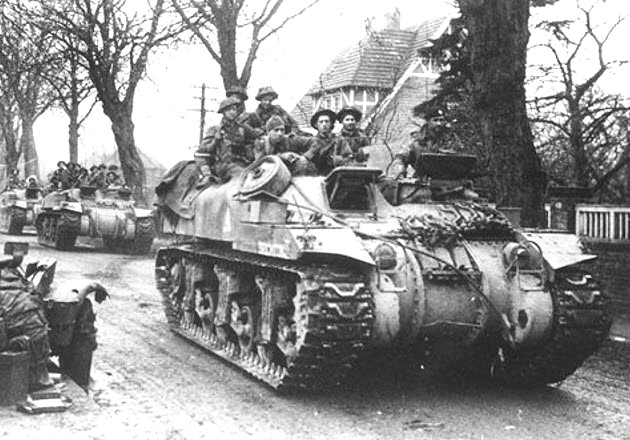
An early morning assembly of LVT IV Buffaloes on the Rhine west bank near Rees. There is a Jeep parked between the two Buffaloes.

A DD Sherman V of C Squadron, Staffordshire Yeomanry, followed by a Caterpillar D8 tractor passing a column of Churchill tanks on their way to the river. The tank in the background is a Churchill AVRE. Note the census number painted on the side of the Sherman’s turret since it would not be visible on the hull side.

Canal Defense Light (CDL) tanks
The CDL tank was a British “secret weapon” which was a powerful carbon-arc searchlight mounted in a tank turret. It was intended to be used during night attacks, when the light could target enemy positions. A secondary use was to dazzle and disorientate enemy troops, making it harder for them to return fire accurately. The name “Canal Defense Light” was used to conceal the device’s true purpose. For the same reason, in US service they were designated the “T10 Medium shop Tractor”.
The searchlight turret included a station for the operator, who had the task of changing the light’s carbon electrodes when they burned out. The light emerged from a vertical slit that was just 2 inches (5.1 cm) wide by 24 inches (61 cm) tall which reduced the chance of battle damage to the optical system. The beam diverged at 19° horizontally and 1.9° vertically, forming a pool of light of around 34 by 340 yards (31 m × 311 m) at a distance of 1000 yards (910 m). The turret could rotate 360° and the light beam could be elevated or lowered by 10° from the horizontal.
Blue and amber filters allowed the light to be colored as well as white. A shutter flashed the beam on and off, up to twice a second. It was found that the blue light caused the CDL tank to appear to be at a greater distance, and blue and amber light beams from two CDL tanks could be combined to illuminate a target with white. The flashing beam would dazzle and disorientate enemy troops by not giving their eyes a chance to adapt to either light or darkness.
This is a M3 Grant CDL tank. The 37mm gun in the turret is a dummy.

The 49th APCR B Squadron equipped with Grant CDLs created “artificial moonlight” by shining the light onto the cloud cover and during the assault on Rees by the 51st Division the Grants both illuminated the crossing and engaged the Germans on the east bank with their 75mm guns. The CDL tanks drew considerable artillery and small arms fire with one of the tanks being knocked out. The CDL tanks were perfect for the task, as they were sufficiently armored to stand up to the enemy fire. Standard searchlights would have been immediately knocked out.
A Jeep is unloaded from a 4th RTR LVT IV Buffalo on the east bank of the Rhine southeast of Rees.

This is my close up of the Jeep in the above photo. The circled HD formation sign of the 51st Division is below the windshield on the left side. On the right side is the Arm of Service (AoS) number 62 on a Green square which indicate that the Jeep belonged to the 5th/7th Battalion Gordon Highlanders of the 153rd Infantry Brigade. Note the ends of the Jeep’s front bumper are bent at an angle and painted white.

A universal carrier of the 51st Division is driven out of a LVT IV Buffalo on the east bank near Rees. The census number on the carrier is T255148.

Sherman DD tanks of the Staffordshire Yeomanry with screens erected are driving down the west bank to the river. The patchy appearance of the flotation screens is because they were camouflage painted when the screens were in the lowered position.

This is my close up of the above photo. Note behind the Shermans there are buildings. They are driving over a levee along side of the river.
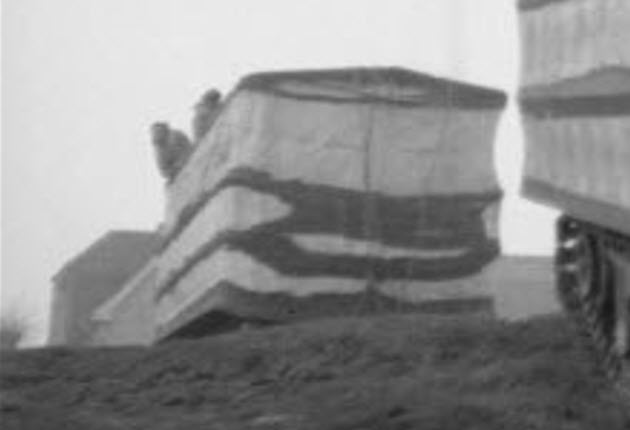
A Sherman DD tank enters the water on the west bank of the Rhine. Note the propeller blades on the rear of the Sherman. Behind the Sherman is the rear of a LVT Buffalo also entering the water.

The Sherman DD tanks had entered the water and have started swimming. The Sherman on the left has the A Squadron triangle tactical marking. Note the propeller wake behind the Sherman on the right.

Sherman DD tanks on the east bank near Rees. The two closest DD Shermans had dropped their flotation screens and are probably waiting for the other tanks. The Sherman in the background still has its screen erected and is shrouded by the smoke screen.

Two DD Shermans of B Squadron, Staffordshire Yeomanry on the east bank of the Rhine near Rees. One has dropped its screen. The other tank’s screen is coming down. In the foreground are two discarded air bottles which were used to inflate the screen supports.

Not all the DD tanks were so lucky. This Sherman DD tank was damaged by a mine after crossing the Rhine.
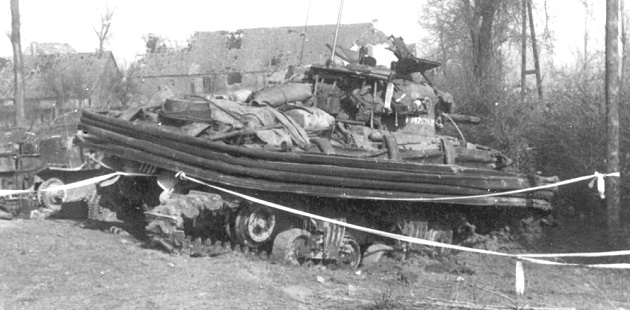
Operation Widgeon
Operation Widgeon was the British crossing of the River Rhine opposite Wesel, 12 hours before the US 17th Airborne and the British 6th Airborne Divisions landed on higher ground to the north of the town.
British 1st Special Service Brigade
- 3rd and 6th Commandos (Royal Army)
- 45th and 46th Commandos (Royal Marines)
- 77th Assault Squadron, 5th Assault Regiment Royal Engineers – LVT Buffaloes
These are LVT II Buffaloes of the 77th Assault Squadron who landed troops of the 1st Battalion, Cheshire Regiment on the afternoon of March 24th, in support of the 1st Special Service Brigade. The bridge in the background is the destroyed railway bridge at Wesel.

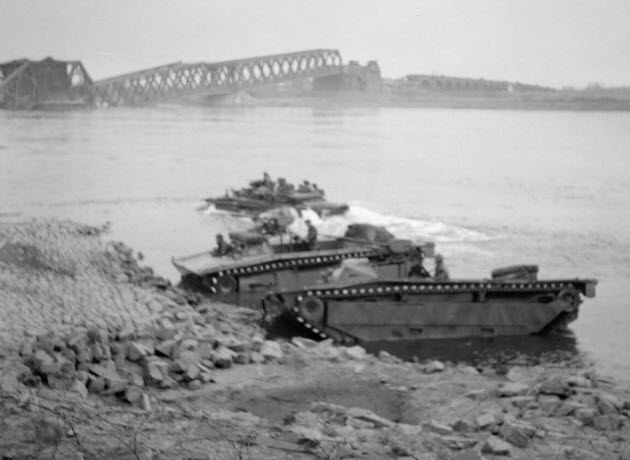
Operation Torchlight
Operation Torchlight was the British main crossing of the Rhine river in the area of Xanten (between Rees and Wesel) on March 24/25.
British 15th (Scottish) Infantry Division
- 15th Scottish Reconnaissance Regiment
- 44th (Lowland) Infantry Brigade
- 46th (Highland) Infantry Brigade
- 227th (Highland) Infantry Brigade:
- 11th RTR – LVT Buffaloes
- 1st East Riding Yeomanry (1ERY) – LVT Buffaloes
- 44th RTR – DD Shermans
The 11th RTR was originally designated for the Canal Defense Light (CDL) role but had not seen any combat. On 29 September 1944, it was ordered to transfer all of its equipment to the 42nd and 49th RTRs, and was retrained to operate LVT Buffaloes. In January 1945, the 1ERY rejoined the 79th Armoured Division and handed in their Shermans and was re-equipped with LVT IVs for the Rhine crossing.
Scottish troops of the 15th Division, some wearing life preservers, climb onto a LVT IV Buffalo of the 11th RTR on March 24. It is not clear why they are climbing a ladder when the LVT IV has a rear ramp.

Scottish troops climb into a LVT II Buffalo of the 11th RTR on March 24th. Note the foot rail added to the side of the Buffalo which made climbing in easier.

LVT IV Buffaloes of 11th RTR moving up to the Rhine on March 24th. This Buffalo is armed with a 20mm Polsten cannon and the machine gun have a boxed shaped gun shield. Note that half rubber tires are mounted on the corners of the front hull used as bumpers. The tire treads can be seen.

This is my close up of IWM BU 2102.
LVT Buffaloes carrying troop across the Rhine on March 24th. The DUKW “Duck” belonged to REME troops who were laying down matting on the river bank. Once a secured bridgehead is established on the west bank and a matted exit point built, the DUKWs would began transporting supplies across the river and deliver them directly to the forward units.

BBC reporter Wynford Vaughan-Thomas (15 August 1908 to 4 February 1987) was aboard the LVT buffalo with the commanding officer of the 6th Royal Scots Fusiliers (6 RSF) of the 44th Brigade during the crossing and he recorded this live report.
Audio: Rhine Crossing: In A Buffalo 24.3.1945
A LVT IV Buffalo landing on the east bank of the Rhine opposite Xanten on March 24th. The A Squadron triangle is on the front of the cab. The bundles attached to the front corners of the hull are used as bumpers.
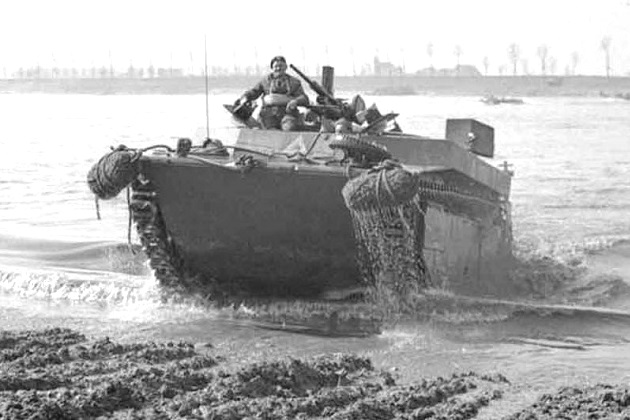
Various problems were reported associated with the Buffaloes. It was discovered that the special tracks, which acted as paddles in the water, had difficulty gripping the stone facings on the far bank. These broke the blades from the track links which gave the crews much extra work to replace them. Even when the stones were broken up, the Buffaloes tracks churned up the mud and made a mess of the turn around areas.
A LVT II Buffalo towing an assault boat carrying troops approaches the east bank of the Rhine across from Xanten on March 24th. This LVT II has the frames fitted for laying matting on muddy river banks. Swimming in the background are DD Shermans.

Buffaloes crossing the Rhine on March 24-25th. The LVT IV in the foreground appears to be carrying a 15cwt (3/4 ton) truck with its front tires on top of the front cab. On the rear ramp appears to be “13 B” painted in white outline numbers and letter.
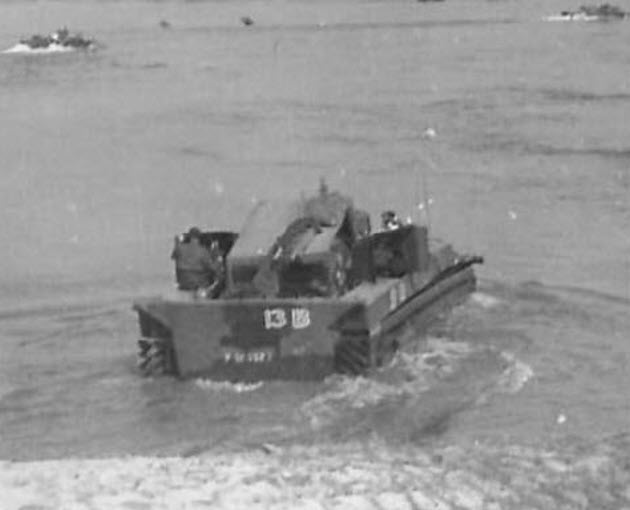
A LVT II Buffalo making its way across the Rhine on March 25th.

This is my close up of the Buffalo in the above photo. The census number is “P5877392”. It appears to have a number “8” on the side of the cab.

Troops of the 5th Dorsetshire Regiment, 43rd (Wessex) Infantry Division crossing the Rhine near Rees in a LVT IV Buffalo on March 28th.

On March 7th, the 44th RTR was withdrawn from the front line and sent to Nijmegen to begin 10 days of training on amphibious tanks for the Rhine crossing. The regiment was concentrated south of Xanten and at 0515 hours on March 24th began crossing the Rhine.
Sherman DD tanks with flotation screens lowered move forward towards the Rhine near Xanten on March 24th. A MP (see arm band) in the foreground is directing the tanks. Note the white tape on the ground which marks the cleared lane.
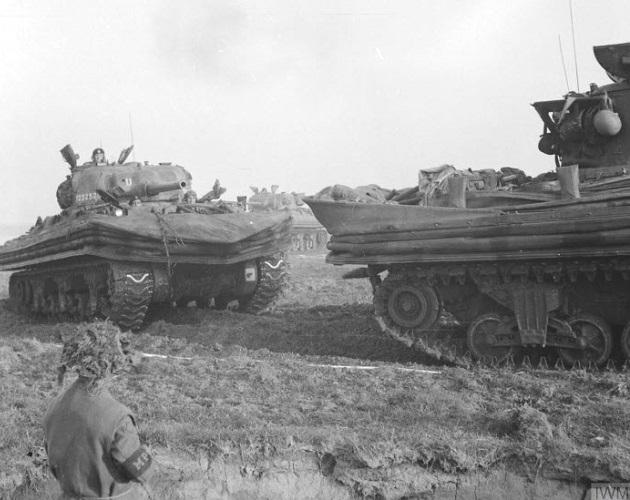
This is my close up of the above photo. Note the census number painted on the side of the turret and the letter “U” on the gun mantlet.
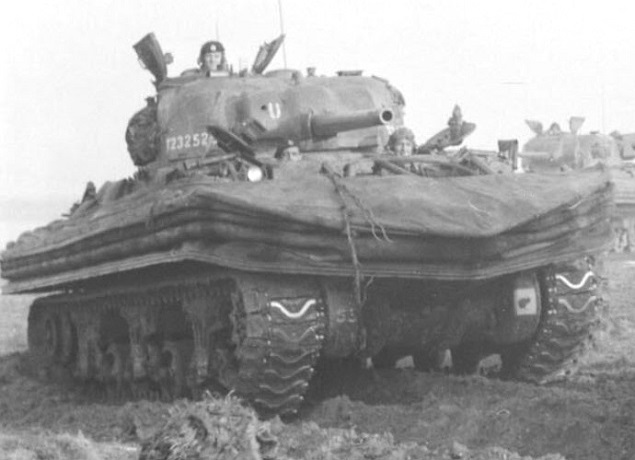
A Sherman DD tank of 44th RTR passing carriers of the 6th King’s Own Scottish Borderers (44th Brigade) east of the Rhine on March 25th. The name “WEDDERLIE” on the carrier on the left is a castle in Scotland.

Operation Varsity
The First Allied Airborne Army was dropped on the east bank of the Rhine in support of Operation Plunder, consisting of US 18th Airborne Corps, the veteran British 6th Airborne Division (dropped in Normandy on D-Day) and the US 17th Airborne Division. The airborne troops was a blocking force tasked with intercepting German reinforcements east of the Diersfordter forest and north of Wesel. The British and US paratroopers were dropped into the area of the Wehrmacht 84. Infanterie-Division.

British 6th Airborne Division
- 6th Airlanding Brigade
- 3rd Parachute Brigade
- 5th Parachute Brigade
- 6th Airborne Reconnaissance regiment – M22 Locust tanks
US 17th Airborne Division
- 507th Parachute Infantry Regiment
- 513th Parachute Infantry Regiment
- 194th Glider Infantry Regiment
The US 17th Airborne “The Golden Talons” was activated in April 1943 and arrived in Britain in August 1944. It was not chosen to participate in Operation Market Garden as the Allied planners believed it had arrived too late and could not be “trained up” in time. After Market Garden, the division was shipped to France and then Belgium to fight in the Ardennes. On 4 January 1945, the division entered combat for the first time when it was alongside the US 87th Infantry Division to seize a number of key towns to the west of Bastogne, in order to prevent German forces from encircling the town a second time. Between January 19th and 26th, the division broke through German lines and captured several towns before linking up with elements of the British 51st Infantry Division. After it captured the town of Espeler on January 26th, the entire division was withdrawn from the front and transported by truck to Luxembourg, ending its participation in the Ardennes campaign. Operation Varsity was the division’s first and only combat airborne drop.
Film: IWM APY 40
Film: Operation Varsity
Film: Operation Varsity Footage Airborne Assault Across the Rhine Near Wesel Germany
Film: Operation Varsity, 24 March 1945 at Marks Hall Estate
M22 Locust tank
Development of the M22 Locust, officially Light Tank (Airborne), M22, began in 1941 after the British War Office requested that the US government design a purpose built airborne light tank which could be transported by glider into battle to support British airborne forces. If was designed and built by the Marmon-Herrington Company. The US Army did not have a large glider to transport it but was designed to be transported underneath a Douglas C-54 Skymaster transport aircraft where the turret was removed and carried inside the transport. Of the 830 M22s built, no US Army armor units had used it in combat, although a number of them were used for training with the infantry.

Video: Tank Chats #87 | Locust | The Tank Museum
The M22 Locust entered British airborne service in early 1944. It was intended to replace the Tetrarch light tank after its completion of service trials and it was planned to be deployed in the invasion of Normandy. But the trials revealed mechanical problems, and the 37mm high explosive round of the US M6 gun was found to be inferior to the 40mm high explosive round of the 2 Pounder gun on the Tetrarch resulting in the Tetrarchs staying in service for the Normandy campaign. After Normandy, in the fall of 1944, the Tetrarch was retired, and completely replaced by the Locust, as the stocks of Tetrarchs could no longer support the operational needs.
The first combat of the Locust in airborne operations was during Operation Varsity. Eight Locusts of the 6th Airborne Reconnaissance regiment were landed by Hamilcar Mk I gliders. They were divided into two troops of four and landed with the 6th Airlanding Brigade in landing zone ‘P’ east of the Diersfordter Wald and west of Hamminkeln, acting as a divisional reserve. The rest of the regiment arrived by road after crossing the Rhine.
This Locust is loaded in a Hamilcar glider with the nose door open. The 6th Airborne Reconnaissance regiment used AoS 41 on Green-over-cobalt blue square. The badge for both the 1st and 6th Airborne Divisions was the light blue Bellerophon-on-Pegasus on a maroon square. The number 7 on a yellow disc is the bridge weight classification.

The census number of this Locust exiting a Hamilcar glider is “T-159184”.

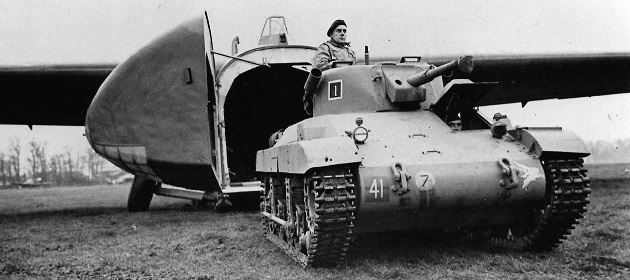
Film: WW2 M22 Locust – Hamilcar Mark I glider – Footage
The Locusts were loaded into separate Hamilcar gliders between March 17th and 20th, and on the morning of March 24th were towed from the airfield by Handley Page Halifax heavy bombers to join the rest of the gliders and transport aircraft carrying the two airborne divisions. Weather conditions for the operation was excellent, with clear visibility, and all eight gliders arrived in the vicinity of the landing zone without incident. During their attempts to land, the small force was severely depleted. One glider broke away from the Halifax towing it and disintegrated, apparently as a result of structural failure, with the Locust inside it falling to the ground. Three more gliders came under heavy German AAA fire and crashed as they landed. One tank survived with a damaged machine gun and another crashed through a house which put its wireless radio set and main armament out of action, and the third broke loose of the glider as it landed and was flipped over onto its turret, rendering it useless.
Six Locusts landed intact on the landing zone, including several with significant damage, but two of these tanks did not reach the rendezvous point chosen for the regiment. One undamaged tank came to the aid of a group of US paratroopers who were under fire from a German self-propelled gun but was rapidly knocked out by the German vehicle, wounding two crew members. A second tank broke down as it attempted to tow a jeep out of a crashed glider, although the crew remained with the tank and provided fire support to British paratroopers in the area. Of the four Locusts that reached the rendezvous point, only two were undamaged and fully fit for action. These two were immediately deployed to the high ground east of the Diersfordter Wald, while being covered by the two damaged tanks. Upon arrival they were engaged by German troops and had to be supported by an infantry company, and soon their presence began attracting a great deal of artillery and anti-tank fire. Although neither of the tanks were hit, a number of infantrymen were killed or wounded and after several hours the tanks were forced to withdraw. The four tanks and remaining infantry formed a small force that repelled several German attacks on their position, and were eventually relieved at 1030 hours by a tank squadron from the 44th RTR and elements of the rest of the 6th Airborne Armoured Reconnaissance Regiment.
Below are two of the few surviving photographs of the M22 Locust in combat during WWII.
Film: IWM WPN 205
This photo is the tank of Lieutenant Kenward of the 6th Airborne Armoured Reconnaissance Regiment. It was taken moments after his crew had left their glider upon landing. The glider’s nose failed to open automatically as it should have as the tank moved forward, so Lieutenant Kenward ordered his driver to drive through the nose of the glider. The damaged skirt over the rear portion of the track may have been inflicted when it drove through the nose of the glider.

This photo is of Lieutenant Kenward Kenward’s tank after his crew’s duel with a self-propelled gun. Identification of the tank can be confirmed by the damaged skirt visible in the above photo. It appears that the tank has burned completely as the markings on the front of the hull and turret sides have been completely burned off. Remarkably, Lieutenant Kenward and at least one of his two crewmen survived and were evacuated back across the Rhine that night.

On the second day of the operation, the situation had stabilized, and the German counterattacks had died down. The remaining Locusts remained in their defensive positions on the perimeter that had been established after pulling back from their attacks the day before. After Operation Plunder, the surviving Locusts were handed over to other units to be used as commanding officers’ vehicles.
This Locust tank was somewhere in Germany after Operation Plunder evident by the missing and damaged front fenders. It still carries the airborne formation sign but the 56 AoS number did not belong to an airborne division. AoS 56 on a red square is for the 2nd Infantry Battalion of the Senior Brigade of an infantry division. The infantry division using this Locust is unknown. Note the “A/T” painted next to the bridge classification disc with a number 7.

After the war, several company sized units of M22 Locusts were used by the Egyptian Army during the 1948 Arab–Israeli War.
The rafting was deployed with mechanized assistance. First, the various components, the large pontoons and sections of Bailey bridge were towed to the river bank. The pontoons were launched by reversing the trailers into the water. While that was being done, Buffaloes were crossing the Rhine carrying motorized winches in their cargo holds which were mounted on the east bank. Similar winches were mounted on the west bank and cables were rigged between the two. Theses winches provided the power to pull ferries back and forth across the river. The taut cables prevented the ferries from drifting too far in the strong current of the Rhine. The ferries were in use until new bridges were built across the Rhine.
An armoured bulldozer making a ramp on the east bank of the Rhine near Rees on March 24th. A LVT IV Buffalo most likely transported it across the Rhine.

An Achilles tank destroyer armed with a 17-pounder gun on the east bank of the Rhine moves up to link up with the airborne forces whose abandoned gliders are in the background. Note the field fabricated armoured roof and the .50 Cal machine gun mounted on the turret. The unit it belonged to is unknown.

A Humber Light Reconnaissance Car Mk I drives off a raft ferry on the east bank of the Rhine on March 25th. The Mk I had a open topped hull and 4×2 wheel drive. The bracket frame on the side of the hull is probably for stringing spools of communication wire.
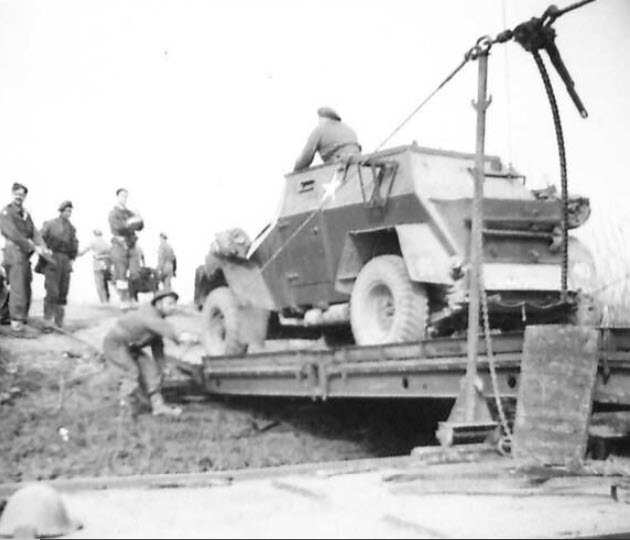
This is my close up of IWM BU 2466.
A collapsed raft drowns two Sherman tanks during crossing on March 25th. A German shell hit the raft’s pontoons sinking it and the tanks close to the west bank.

This is my close up of IWM BU 2460.
This is the heavily camouflaged Sherman tank in the above photo after it was pulled out of the river on March 25th.
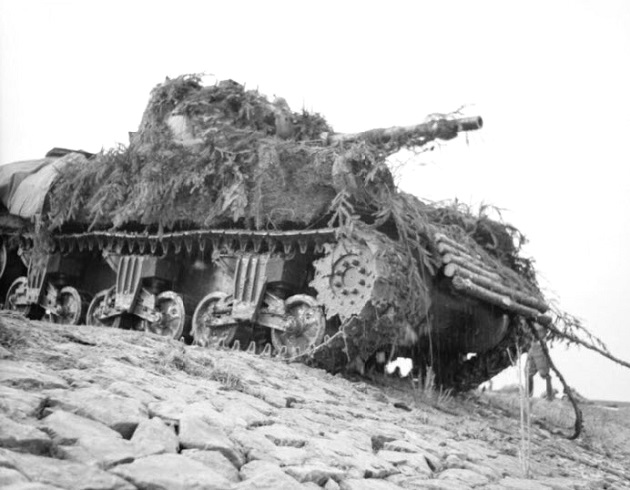
Sherman DD tanks advance past an abandoned Hamilcar glider during the link up between ground and airborne forces east of the Rhine on March 26th. Note that the Hamilcar glider has black/white invasion stripes under the wings.

This is my close up of IWM BU 2400.
Winston Churchill
Throughout the war, Churchill visited front line units and tempted fate many times probably due to his Army service during WWI. As a Lieutenant Colonel, he commanded the 6th Royal Scots Fusiliers Regiment from January to 16 May 1916 which fought on the Belgian Front near Ploegsteert (southeast of Dunkirk).
In 1944, Churchill wanted to land on the beaches in Normandy on D-Day but many advised him that it was not possible. A week later on June 14th, he toured the Normandy beaches with Field Marshal Montgomery after the beaches were secured. By 10 March 1945, the Allies were on the west bank of Rhine and crossing it was important and a historic event which Churchill did not want to miss. Besides that, the regiment which he commanded in WWI was crossing the Rhine with the 15th Scottish Division.
Prime Minister Churchill is riding in this Daimler armoured car through the ruins of Xanten.
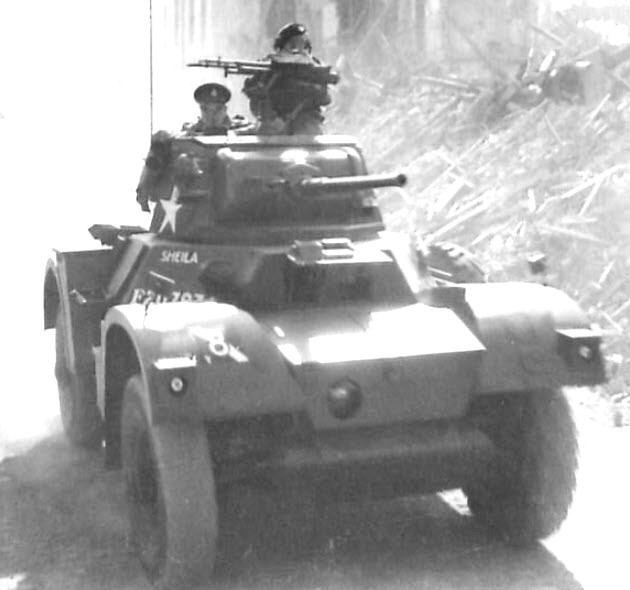
Film: Invasion Scenes – Europe (1944)
This is my screen capture from the above film. The 70 year old Churchill used a ladder to climb onto the armoured car. The Arm of Service (AoS) number 8 is clearly seen. The meaning of the small letter “T” is unknown.

This is another screen capture from the same film. The armoured car name is “SHEILA” which is a female name of Irish and Gaelic origin meaning “blind”. The crewman (probably the commander) standing behind the turret is pulling up the ladder.

Rear view of the armoured car driving through a village on the Xanten-Kalkar Road. The chevron shape engine louvers on the rear indicate it is a Daimler Mk I armoured car. The ladder is laying across the engine deck behind the turret.

This side view shows the turret details and the twin Vickers K machine guns on the pedestal mount.

Churchill addressing troops from the armoured car before leaving the British 3rd Division HQ. The 3rd Division crossed over the Rhine at Rees.
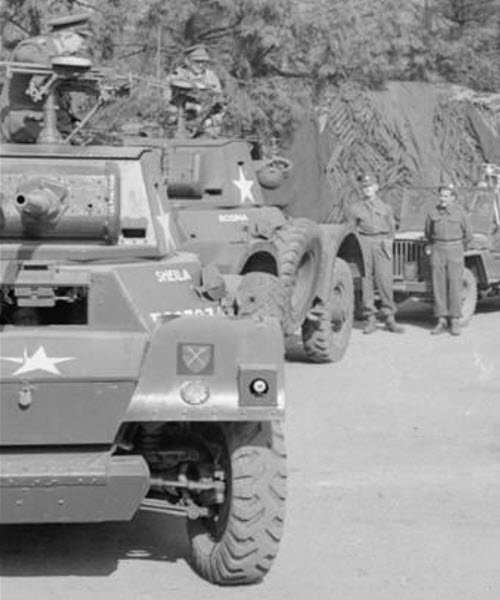
This is my close up of IWM BU 2274.
On March 25th, Churchill crossed the Rhine River to the east bank, south of Wesel, in an US Landing Craft Vehicle Personnel (LCVP or a Higgins boat) with Field Marshal Montgomery, Chief of the British Imperial General Staff, Field Marshal Sir Alan Brooke and General Simpson (US 9th Army). They inspected the British and US bridgeheads and while standing on the destroyed western end of the railroad bridge at Wesel, a German artillery shell landed within 50 yards (45.72 meters) of the group. After the close call, the group quickly crossed back to the west bank of Rhine.
Video: Winston Churchill – Nearly Killed by the Germans in 1945
The next day, March 26th, Churchill crossed the Rhine River again. This time he rode in a Jeep with Lieutenant General Miles Christopher Dempsey (commander of the British 2nd Army) over a pontoon bridge.

After his safe tour of the east bank, Churchill was ferried back across the Rhine in a LVT-2 Buffalo (no rear ramp) from C Squadron, 11th RTR. Churchill is seen here climbing the ladder.

In the LVT-2 Buffalo, Churchill was accompanied by Field Marshal Brooke (second to Churchill’s left), Lieutenant General Dempsey (to Churchill’s left), and Field Marshal Montgomery (second from right behind Churchill).

Operation Flashpoint
Operation Flashpoint was the 9th US Army (commanded by General Simpson) part of Operation Plunder establishing bridgeheads in the sector between Wesel and Walsum on the west bank of the Rhine.
US 30th Infantry Division “Old Hickory”
- Company D, 18th Tank Battalion, 8th Armored Division – M24 Chaffees
- Company C, 736th Tank Battalion – DD amphibious Shermans
- 743rd Tank Battalion – DD amphibious Shermans
- 744th Light Tank Battalion – M24s
- 747th Tank Battalion – LVT amtracs
- 807th Tank Destroyer Battalion – M18s
- 823rd Tank Destroyer Battalion – M10s
US 79th Infantry Division “Cross of Lorraine”
- 717th Tank Battalion – M4A3 Shermans
- 809th Tank Destroyer Battalion – M18s
- 813th Tank Destroyer Battalion – M36s
The 30th Division crossing points were between Wallach and Rhienburg while 79th Division crossings were north of Orsoy and west of Walsum.

A LVT-4 Amtrack landing in support of the 30th Infantry Division on March 24th. It most likely belonged to the 747th Tank Battalion.

These two M24 Chaffees are loading into landing crafts on the west bank. There are soldiers standing in front of both tanks giving hand signals to the tank drivers. These M24s either belonged to the 18th or 744th Tank Battalion. Note that the M24 on the right has sandbags covering the hull and turret sides.

This M4A3(76)W Sherman of the 717th Tank Battalion has disembarked from a landing craft on the east bank of the Rhine. The 717th first entered combat with the US 79th Infantry Division on 8 March 1945.

These two 90mm M36s probably of the 813th Tank Destroyer Battalion are disembarking from landing craft on the east bank. On the front hull of the M36 on the left “B24” can be seen.

At 1600 hours on March 25th, Task Force Hunt consisting of 744th M24s, 2/120th Infantry (30th Division) and two companies of 823rd M10 Tank Destroyers attacked south towards Kirchhellen ran into Pz.Gren.Regt.60, 116. Panzer-Division. In the ensuing fight, four Sd.Kfz.251/21s including this one seen here to the right with tactical number 451. The 251/21 was the anti-aircraft and ground support variant equipped with three MG151 15mm or 20mm auto cannons on a Kriegsmarine mount with a gun shield.

This Sherman DD tank of C Company, 736th Tank Battalion was knocked out in the fighting on March 26th while supporting the US 30th Infantry Division. This was one of 17 US DD tanks that crossed the Rhine on March 24th. Many of the US DD tanks had damaged canvas screens or other equipment which rendered the tanks unable to swim and they had to be ferried across the Rhine.
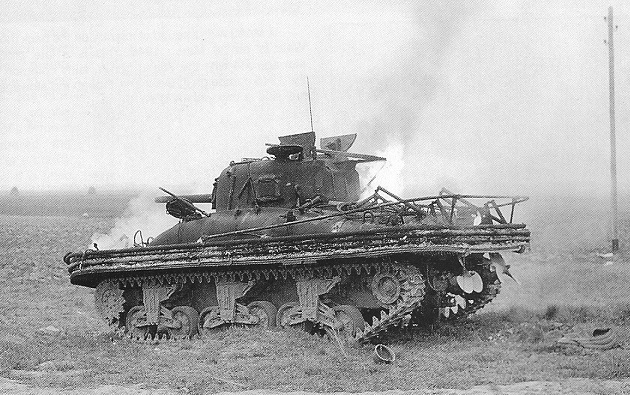
6th Guards Tank Brigade
The 6th Brigade was converted from the 30th Independent (Guards) Infantry Brigade. In 1942, all British armoured divisions were reorganized to have one armoured brigade and one motorized infantry brigade. The 6th Guards Armoured Brigade became an independent tank brigade and renamed as the 6th Guards Tank Brigade. The brigade equipped with Churchill tanks fought in the northwest Europe campaign landing in Normandy on 20 July 1944. After Operations Blackcock (13-26 January 1945) and Veritable (8 February and 11 March 1945) and just prior to Operation Plunder, the 6th Guards had Artillery, Engineer and other units added to the formation. The brigade then was renamed the 6th Guards Armoured Brigade again.
The brigade consisted of the:
- 4th Tank Battalion, Coldstream Guards
- 4th Tank Battalion, Grenadier Guards
- 3rd Tank Battalion, Scots Guards
On March 29th, Churchill tanks of the 6th Guards Armoured Brigade picked up paratroopers of the 513rd Parachute Infantry Regiment, US 17th Airborne Division at an assembly point west of Wesel and traveled east following the RR line along the Lippe river towards Derston, Germany.

6th Guards Churchill tanks carrying US 17th Airborne paratroopers traveling east.
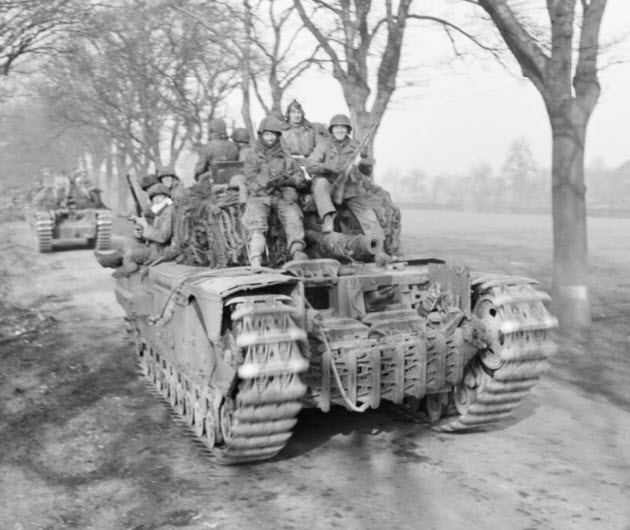
A British tank crewman gives a light to a US paratrooper.

Churchill tanks carrying US paratroopers approaches Derston.
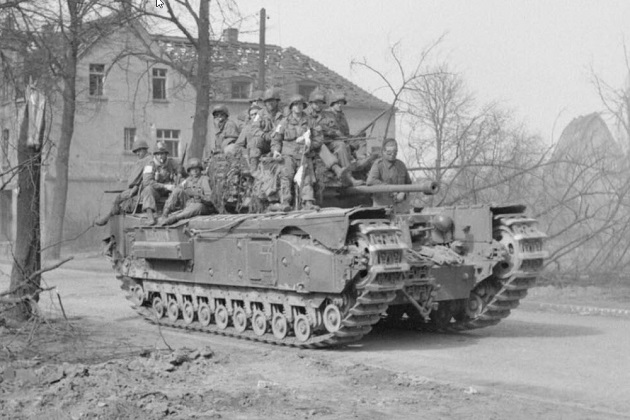
Churchill tanks with US paratroopers driving past Derston north of the Lippe river. The crew of an Achilles tank destroyer is watching the column pass by .
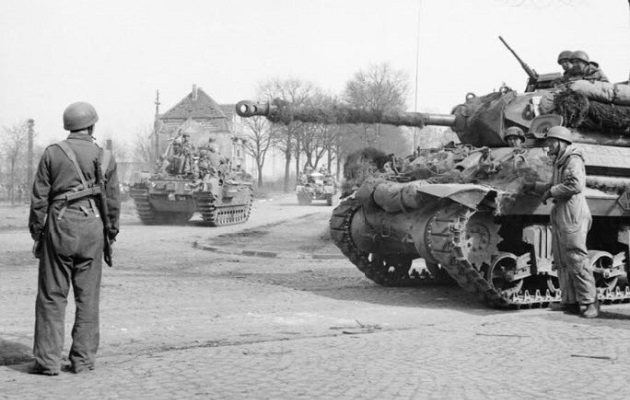

This is the rear view of one of the Churchill tanks.

This is my close up of the above photo. The name “EAGLE” can be seen on the tank’s hull side louver. Note the darker paint color behind the name. The tank was probably repainted and the original name was not over painted.

This is another Churchill tank in the column carrying US paratroopers. The US soldier in the center on top of the turret is holding a Browning Automatic Rifle (BAR) with a folding bi-pod.

Today
In 1947 after a number of storms and the thaw from an exceptionally cold winter, Crowland Low Wash as it is known close to the town of Crowland in Lincolnshire began to overflow one of its banks causing a breach. Large areas of nearby farmland were flooded and 16 WWII LVT Buffaloes were brought in to help seal the breach.
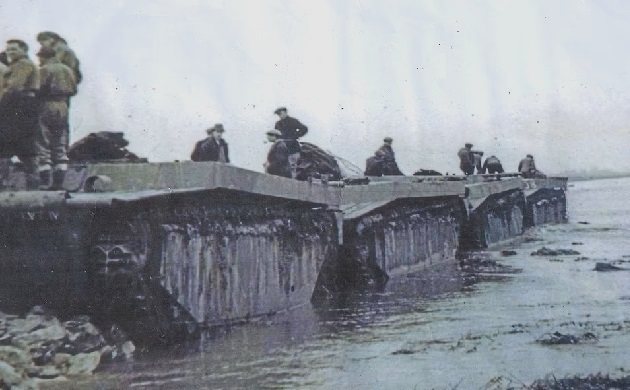
On Friday 11 April 1947, a second breach occurred at 7 AM and the water swept away five of the LVTs. A local newspaper reported that one of the vehicles whirled away like a matchstick and was sucked down into the 28 foot (8.5 meters) hole created by the original breach.
Click HERE to read the news article of its amazing recovery.

Video: Collings Foundation 2016 – M22 Locust Airmobile Light Tank
Kibbutz Negba Memorial Museum
Egyptian Locust Tank, captured by the Israeli Army during the battle of Negba, 1948 Arab–Israeli War. Negba is a kibbutz in southern Israel located in the northern Negev desert near the cities of Kiryat Malakhi and Ashkelon. When the Egyptians invaded on 15 May 1948, their forces advanced and captured the police station, Iraq-Suweidan, a Tegart fort named after the nearby Arab village, that controlled the route to the Negev. Besides the police station, the Egyptians seized Arab villages near the kibbutz, from which they attacked Israeli vehicles traveling on the roads from Ashkelon to Hebron and Jerusalem. The kibbutz was destroyed in the heavy fighting which went on for three months. On 9 November 1948, after the defeat of the Egyptian army in Operation Yoav, the police station was captured by Israeli forces.
A memorial to the fallen soldiers was constructed next to the military cemetery: a man and a woman from the kibbutz with a fighting soldier. Next to the memorial statue stands a captured Egyptian M22 tank. The kibbutz water tower, pockmarked with bullet holes, is a testimony of the fierce battle.

Model Kits and Decals
1/35
Resicast 35.121 Sherman DD Mk.I with lowered screen (Resin kit) – 200?
AFV Club AF35205 U.S. Water Buffalo LVT-4 Early Type – 2011
Bronco CB35161 M22 Locust (T9E1) Airborne Tank (British Version) – 2013
Takom 2116 M3 Grant CDL – 2018
Gecko Models 35GM0011 Daimler Armoured Car Mk.I – 2021
Resicast 35.1215 Polsten & .30 cal Box Shields – 2010
HD Models HDM35220 Polsten 20mm Gun (2 in 1) – 2023
Bison Decals 35170 British LVT-4 Buffalo #3 – Holland and Germany Decalset
1/48
Gaso.line GAS50169K Buffalo Amtrac LVT(A)-2 (Resin kit)
1/72
Dragon 7389 LVT-4 Water Buffalo + 1/4-ton 4×4 Truck (Jeep) – 2012
Mirage Hobby 729001 M3 General Grant CDL Rheinland, March 1945 – 2013
S-Model (China) PS720021 M22 Locust Airborne Tank – 2022
IBG Models 72144 British Daimler Armoured Car Mk.I (“Sheila”) – 2024
